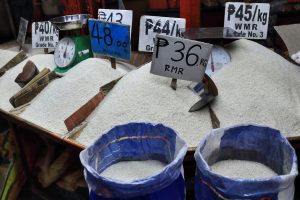In late January, President Ferdinand Marcos Jr. of the Philippines flew to Vietnam to ink a number of deals on various economic and security issues. One that caught my attention was a memorandum of understanding in which Vietnam agreed to supply the Philippines with between 1.5 and 2 million metric tons of white rice at a “competitive and affordable price” for five years. Why is this important?
Well, rice is a staple food in almost every country in Southeast Asia. It is eaten daily by many people, and that means how much is produced, how much is consumed, and how much is traded (and the prices at which these activities are conducted) is very important.
The Philippines is not self-sufficient in rice production, meaning it consumes more than it produces and therefore often depends on imported rice to make up the difference. This dependence is exacerbated during periods of drought and inclement weather, when yields are lower and the Philippines is forced to import even more rice. In 2023, the Philippines imported over 3 million metric tons of rice.
A similar dynamic prevails in Indonesia, where self-sufficiency in rice production has been an important goal of the government for decades. The politics are complicated, but basically some years Indonesia produces enough rice to satisfy domestic demand, and in other years it does not and needs to import rice. Rice is stockpiled by the state to smooth out price volatility and, if it can help it, the government prefers to avoid imports but sometimes it has no choice. Like the Philippines, bouts of bad weather and drought can have a big impact on this delicate balance.
It so happens that 2023 was a year of bad weather, as the dry season was really dry due to El Nino conditions. Lower rainfall impaired harvests and reduced rice production around the region. More and more these days, when this happens – when there is a possibility that supply might lag demand and therefore cause shortages, not just in rice, but any important commodity – we are seeing countries prioritize domestic markets rather than global markets.
Last year, in anticipation of the coming drought, India announced it would stop exporting non-basmati rice in order to ensure there was sufficient domestic supply. India is the largest rice exporter in the world, so this obviously roiled markets. A country like the Philippines, which was already looking at lower rice yields because of El Nino, now had to contend with a major exporter choking off supply to global markets which inevitably started driving up rice prices for importers like the Philippines.
Fortunately, two of the biggest rice-producing countries in the world are not far away: Vietnam and Thailand. What the MoU that was signed in Vietnam does is guarantee that, whatever happens in the next five years, the Philippines is guaranteed a steady supply of rice from one of their major rice-producing neighbors. The language on price (“competitive and affordable”) is vague, but at least the Philippines now knows that if India decides to enact another export ban in the next five years, or if there are more droughts, the Vietnamese rice will be there.
And this is important precisely because climate change is making such unstable weather patterns more common, which is having an impact on long-established patterns of agricultural production. Supply chains are also becoming more precarious, both due to resource scarcity and rising geopolitical tensions. Relying on the power of markets and free trade alone to provide a staple food like rice at an affordable price is becoming an increasingly risky proposition. Negotiating these kinds of back-stops with trade partners that have a surplus of critical commodities is a way to reduce some of that risk. And it’s also something that the Association of Southeast Asian Nations (ASEAN) is well situated to do.
ASEAN has struggled to be effective when it comes to geopolitical and security issues. But when it comes to trade and economic issues (like cross-border payment systems) the bloc has had more success. This is a situation where it is in the best interest of countries in the region to make reciprocal arrangements with one another to ensure steady access to critical commodities – such as rice, coal, or palm oil – even when global supply chains are under pressure. The deal between Vietnam and the Philippines does just that, and is a step in the right direction.

































